Leadership and Operations Management Report: M&S Case Study Analysis
VerifiedAdded on 2023/01/06
|13
|4210
|39
Report
AI Summary
This report provides a detailed analysis of leadership and operations management, using Marks & Spencer (M&S) as a case study. It begins by defining and comparing the roles and characteristics of leaders and managers, highlighting their differences and similarities. The report then examines how leadership and management functions apply in various situational contexts, such as new product launches and conflict management. Furthermore, it applies different leadership theories, including situational, systems, and contingency leadership, to the organizational context of M&S. The report also explains key approaches to operations management and the roles of leaders and managers within this framework. Finally, it assesses the factors within the business environment that impact operational management and decision-making by leaders and managers, providing a comprehensive overview of leadership and management principles in a practical business setting.
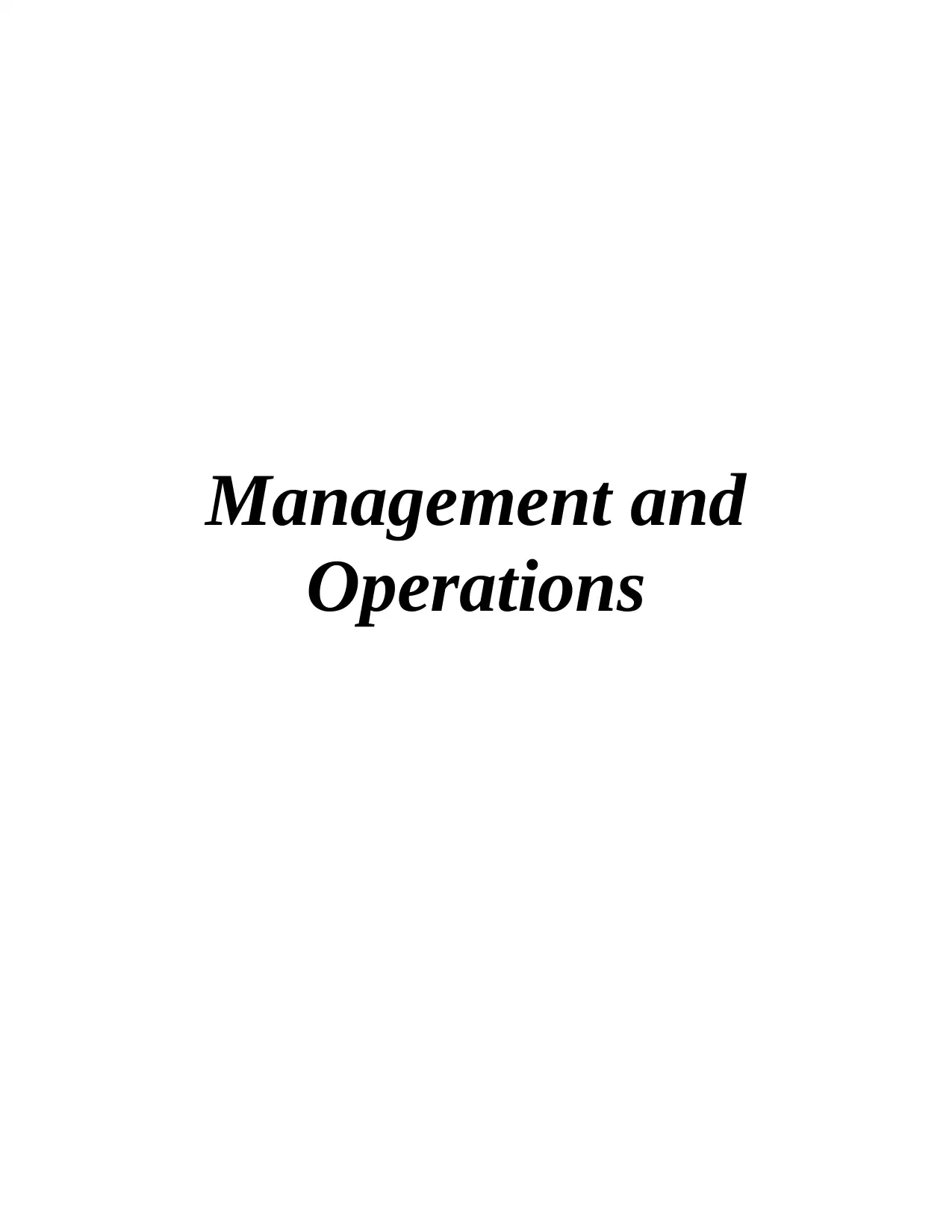
Management and
Operations
Operations
Paraphrase This Document
Need a fresh take? Get an instant paraphrase of this document with our AI Paraphraser
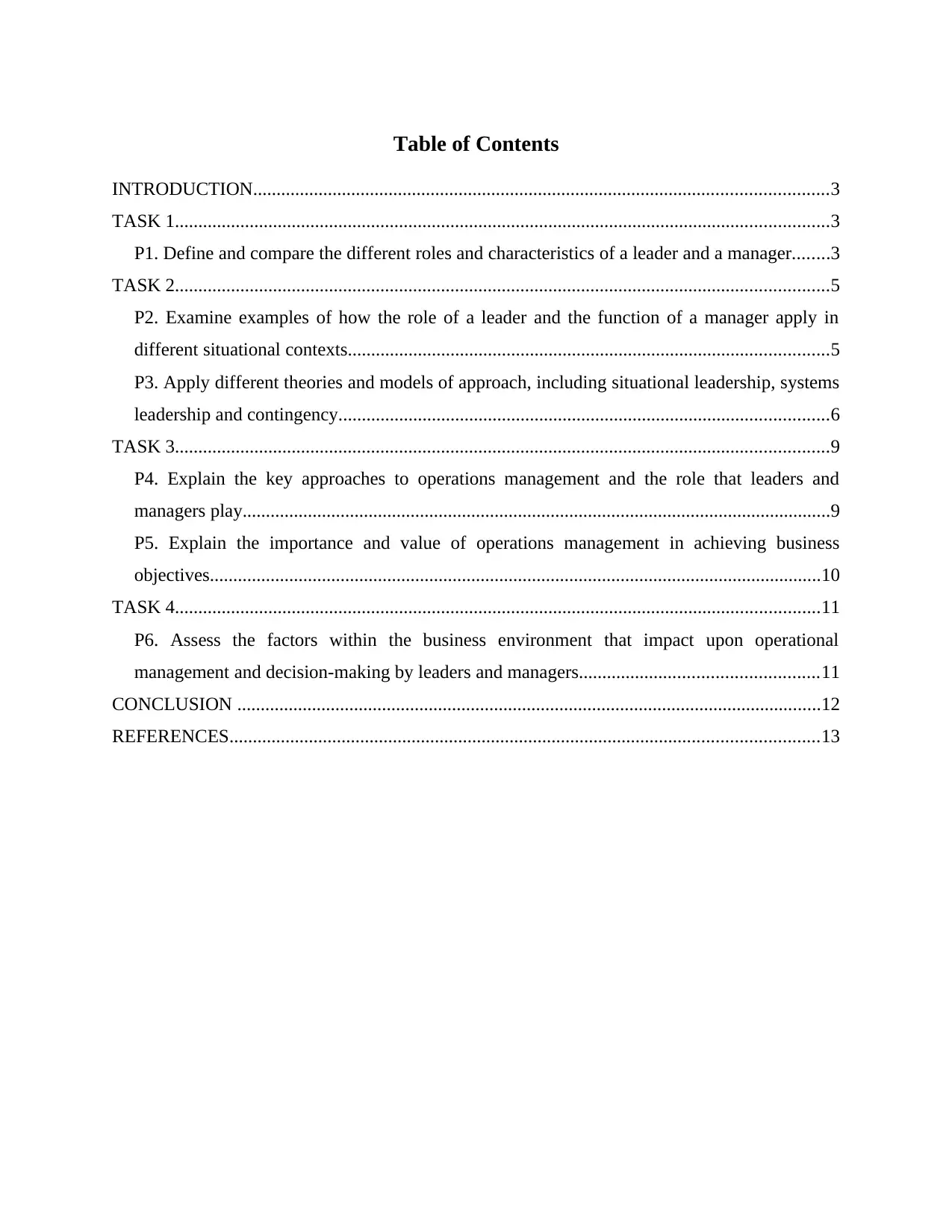
Table of Contents
INTRODUCTION...........................................................................................................................3
TASK 1............................................................................................................................................3
P1. Define and compare the different roles and characteristics of a leader and a manager........3
TASK 2............................................................................................................................................5
P2. Examine examples of how the role of a leader and the function of a manager apply in
different situational contexts.......................................................................................................5
P3. Apply different theories and models of approach, including situational leadership, systems
leadership and contingency.........................................................................................................6
TASK 3............................................................................................................................................9
P4. Explain the key approaches to operations management and the role that leaders and
managers play..............................................................................................................................9
P5. Explain the importance and value of operations management in achieving business
objectives...................................................................................................................................10
TASK 4..........................................................................................................................................11
P6. Assess the factors within the business environment that impact upon operational
management and decision-making by leaders and managers...................................................11
CONCLUSION .............................................................................................................................12
REFERENCES..............................................................................................................................13
INTRODUCTION...........................................................................................................................3
TASK 1............................................................................................................................................3
P1. Define and compare the different roles and characteristics of a leader and a manager........3
TASK 2............................................................................................................................................5
P2. Examine examples of how the role of a leader and the function of a manager apply in
different situational contexts.......................................................................................................5
P3. Apply different theories and models of approach, including situational leadership, systems
leadership and contingency.........................................................................................................6
TASK 3............................................................................................................................................9
P4. Explain the key approaches to operations management and the role that leaders and
managers play..............................................................................................................................9
P5. Explain the importance and value of operations management in achieving business
objectives...................................................................................................................................10
TASK 4..........................................................................................................................................11
P6. Assess the factors within the business environment that impact upon operational
management and decision-making by leaders and managers...................................................11
CONCLUSION .............................................................................................................................12
REFERENCES..............................................................................................................................13
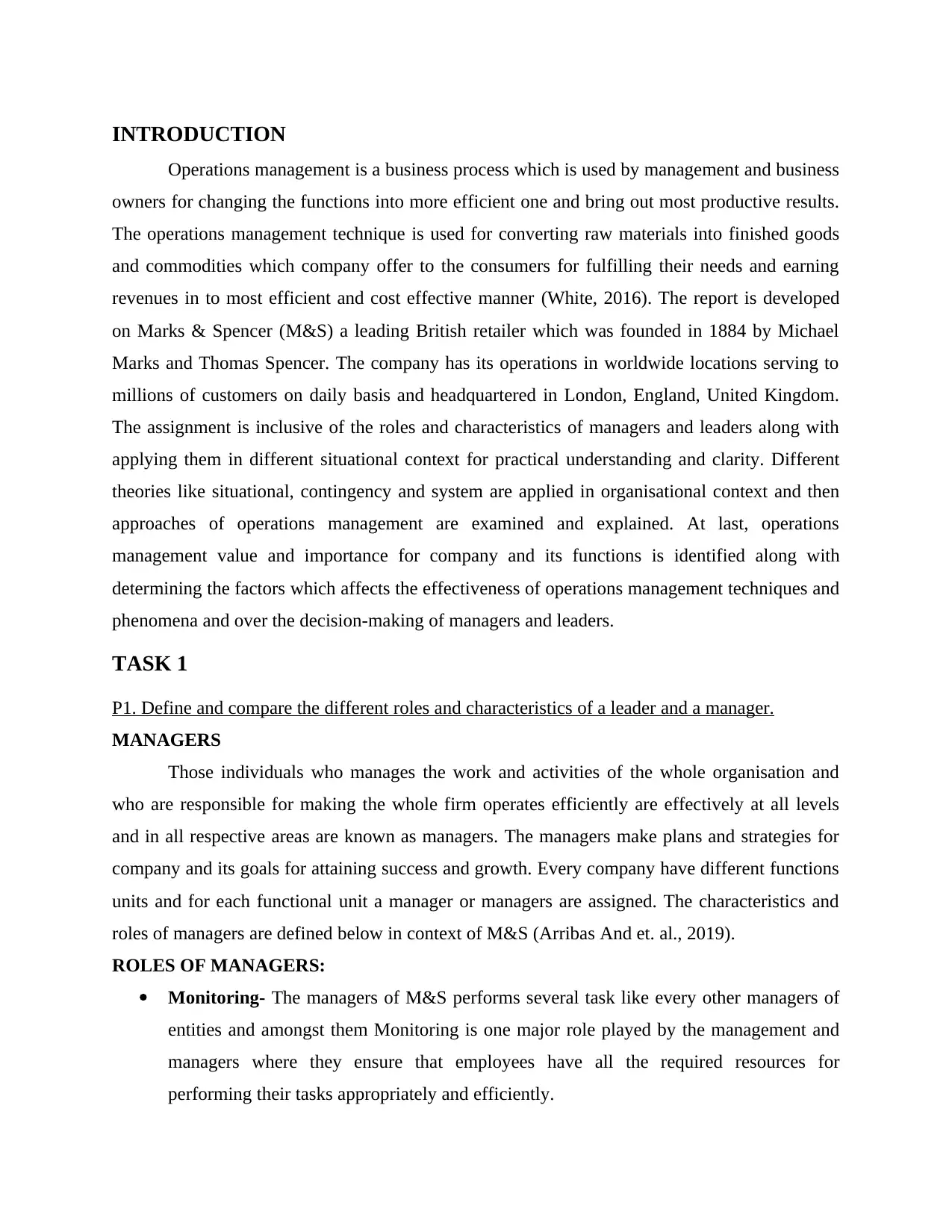
INTRODUCTION
Operations management is a business process which is used by management and business
owners for changing the functions into more efficient one and bring out most productive results.
The operations management technique is used for converting raw materials into finished goods
and commodities which company offer to the consumers for fulfilling their needs and earning
revenues in to most efficient and cost effective manner (White, 2016). The report is developed
on Marks & Spencer (M&S) a leading British retailer which was founded in 1884 by Michael
Marks and Thomas Spencer. The company has its operations in worldwide locations serving to
millions of customers on daily basis and headquartered in London, England, United Kingdom.
The assignment is inclusive of the roles and characteristics of managers and leaders along with
applying them in different situational context for practical understanding and clarity. Different
theories like situational, contingency and system are applied in organisational context and then
approaches of operations management are examined and explained. At last, operations
management value and importance for company and its functions is identified along with
determining the factors which affects the effectiveness of operations management techniques and
phenomena and over the decision-making of managers and leaders.
TASK 1
P1. Define and compare the different roles and characteristics of a leader and a manager.
MANAGERS
Those individuals who manages the work and activities of the whole organisation and
who are responsible for making the whole firm operates efficiently are effectively at all levels
and in all respective areas are known as managers. The managers make plans and strategies for
company and its goals for attaining success and growth. Every company have different functions
units and for each functional unit a manager or managers are assigned. The characteristics and
roles of managers are defined below in context of M&S (Arribas And et. al., 2019).
ROLES OF MANAGERS:
Monitoring- The managers of M&S performs several task like every other managers of
entities and amongst them Monitoring is one major role played by the management and
managers where they ensure that employees have all the required resources for
performing their tasks appropriately and efficiently.
Operations management is a business process which is used by management and business
owners for changing the functions into more efficient one and bring out most productive results.
The operations management technique is used for converting raw materials into finished goods
and commodities which company offer to the consumers for fulfilling their needs and earning
revenues in to most efficient and cost effective manner (White, 2016). The report is developed
on Marks & Spencer (M&S) a leading British retailer which was founded in 1884 by Michael
Marks and Thomas Spencer. The company has its operations in worldwide locations serving to
millions of customers on daily basis and headquartered in London, England, United Kingdom.
The assignment is inclusive of the roles and characteristics of managers and leaders along with
applying them in different situational context for practical understanding and clarity. Different
theories like situational, contingency and system are applied in organisational context and then
approaches of operations management are examined and explained. At last, operations
management value and importance for company and its functions is identified along with
determining the factors which affects the effectiveness of operations management techniques and
phenomena and over the decision-making of managers and leaders.
TASK 1
P1. Define and compare the different roles and characteristics of a leader and a manager.
MANAGERS
Those individuals who manages the work and activities of the whole organisation and
who are responsible for making the whole firm operates efficiently are effectively at all levels
and in all respective areas are known as managers. The managers make plans and strategies for
company and its goals for attaining success and growth. Every company have different functions
units and for each functional unit a manager or managers are assigned. The characteristics and
roles of managers are defined below in context of M&S (Arribas And et. al., 2019).
ROLES OF MANAGERS:
Monitoring- The managers of M&S performs several task like every other managers of
entities and amongst them Monitoring is one major role played by the management and
managers where they ensure that employees have all the required resources for
performing their tasks appropriately and efficiently.
⊘ This is a preview!⊘
Do you want full access?
Subscribe today to unlock all pages.

Trusted by 1+ million students worldwide
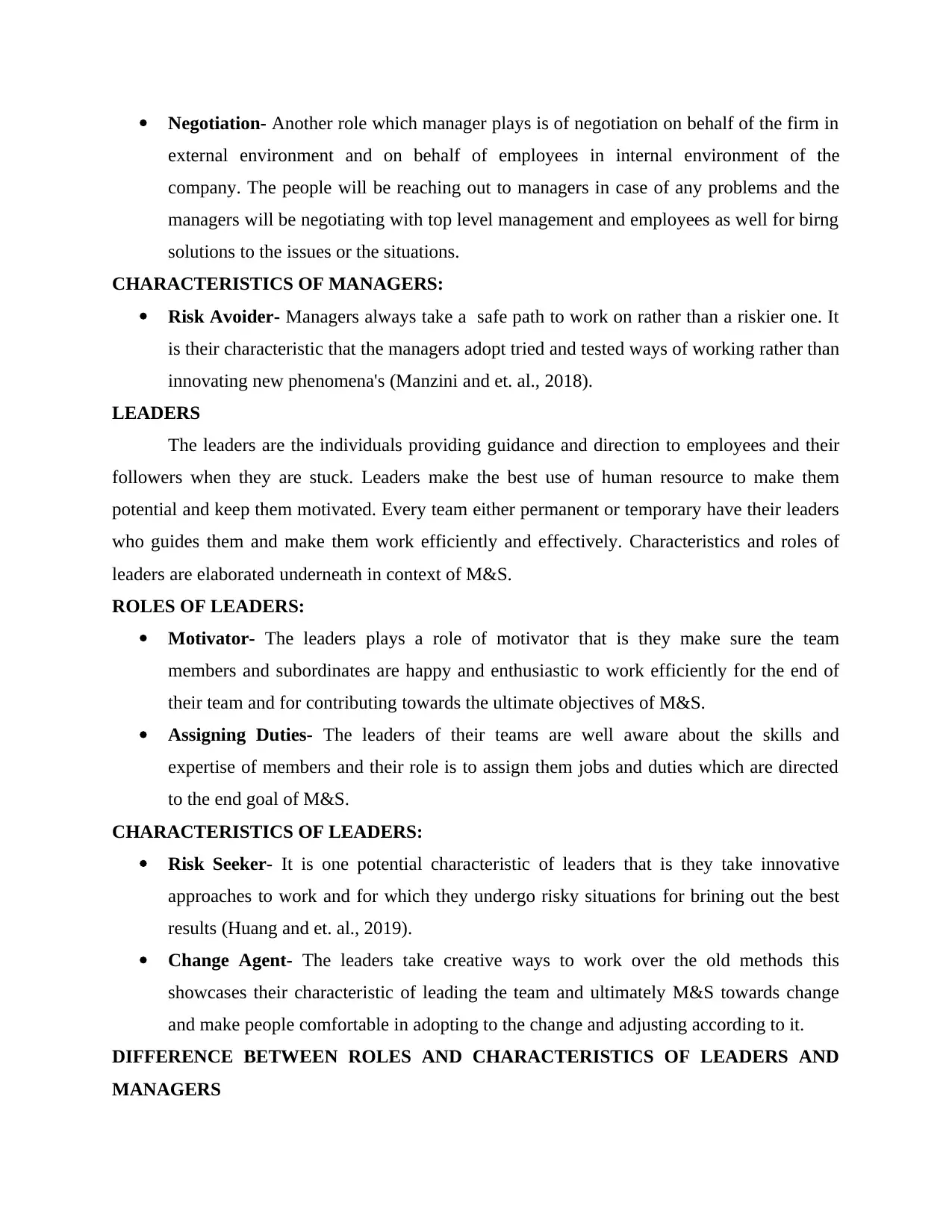
Negotiation- Another role which manager plays is of negotiation on behalf of the firm in
external environment and on behalf of employees in internal environment of the
company. The people will be reaching out to managers in case of any problems and the
managers will be negotiating with top level management and employees as well for birng
solutions to the issues or the situations.
CHARACTERISTICS OF MANAGERS:
Risk Avoider- Managers always take a safe path to work on rather than a riskier one. It
is their characteristic that the managers adopt tried and tested ways of working rather than
innovating new phenomena's (Manzini and et. al., 2018).
LEADERS
The leaders are the individuals providing guidance and direction to employees and their
followers when they are stuck. Leaders make the best use of human resource to make them
potential and keep them motivated. Every team either permanent or temporary have their leaders
who guides them and make them work efficiently and effectively. Characteristics and roles of
leaders are elaborated underneath in context of M&S.
ROLES OF LEADERS:
Motivator- The leaders plays a role of motivator that is they make sure the team
members and subordinates are happy and enthusiastic to work efficiently for the end of
their team and for contributing towards the ultimate objectives of M&S.
Assigning Duties- The leaders of their teams are well aware about the skills and
expertise of members and their role is to assign them jobs and duties which are directed
to the end goal of M&S.
CHARACTERISTICS OF LEADERS:
Risk Seeker- It is one potential characteristic of leaders that is they take innovative
approaches to work and for which they undergo risky situations for brining out the best
results (Huang and et. al., 2019).
Change Agent- The leaders take creative ways to work over the old methods this
showcases their characteristic of leading the team and ultimately M&S towards change
and make people comfortable in adopting to the change and adjusting according to it.
DIFFERENCE BETWEEN ROLES AND CHARACTERISTICS OF LEADERS AND
MANAGERS
external environment and on behalf of employees in internal environment of the
company. The people will be reaching out to managers in case of any problems and the
managers will be negotiating with top level management and employees as well for birng
solutions to the issues or the situations.
CHARACTERISTICS OF MANAGERS:
Risk Avoider- Managers always take a safe path to work on rather than a riskier one. It
is their characteristic that the managers adopt tried and tested ways of working rather than
innovating new phenomena's (Manzini and et. al., 2018).
LEADERS
The leaders are the individuals providing guidance and direction to employees and their
followers when they are stuck. Leaders make the best use of human resource to make them
potential and keep them motivated. Every team either permanent or temporary have their leaders
who guides them and make them work efficiently and effectively. Characteristics and roles of
leaders are elaborated underneath in context of M&S.
ROLES OF LEADERS:
Motivator- The leaders plays a role of motivator that is they make sure the team
members and subordinates are happy and enthusiastic to work efficiently for the end of
their team and for contributing towards the ultimate objectives of M&S.
Assigning Duties- The leaders of their teams are well aware about the skills and
expertise of members and their role is to assign them jobs and duties which are directed
to the end goal of M&S.
CHARACTERISTICS OF LEADERS:
Risk Seeker- It is one potential characteristic of leaders that is they take innovative
approaches to work and for which they undergo risky situations for brining out the best
results (Huang and et. al., 2019).
Change Agent- The leaders take creative ways to work over the old methods this
showcases their characteristic of leading the team and ultimately M&S towards change
and make people comfortable in adopting to the change and adjusting according to it.
DIFFERENCE BETWEEN ROLES AND CHARACTERISTICS OF LEADERS AND
MANAGERS
Paraphrase This Document
Need a fresh take? Get an instant paraphrase of this document with our AI Paraphraser
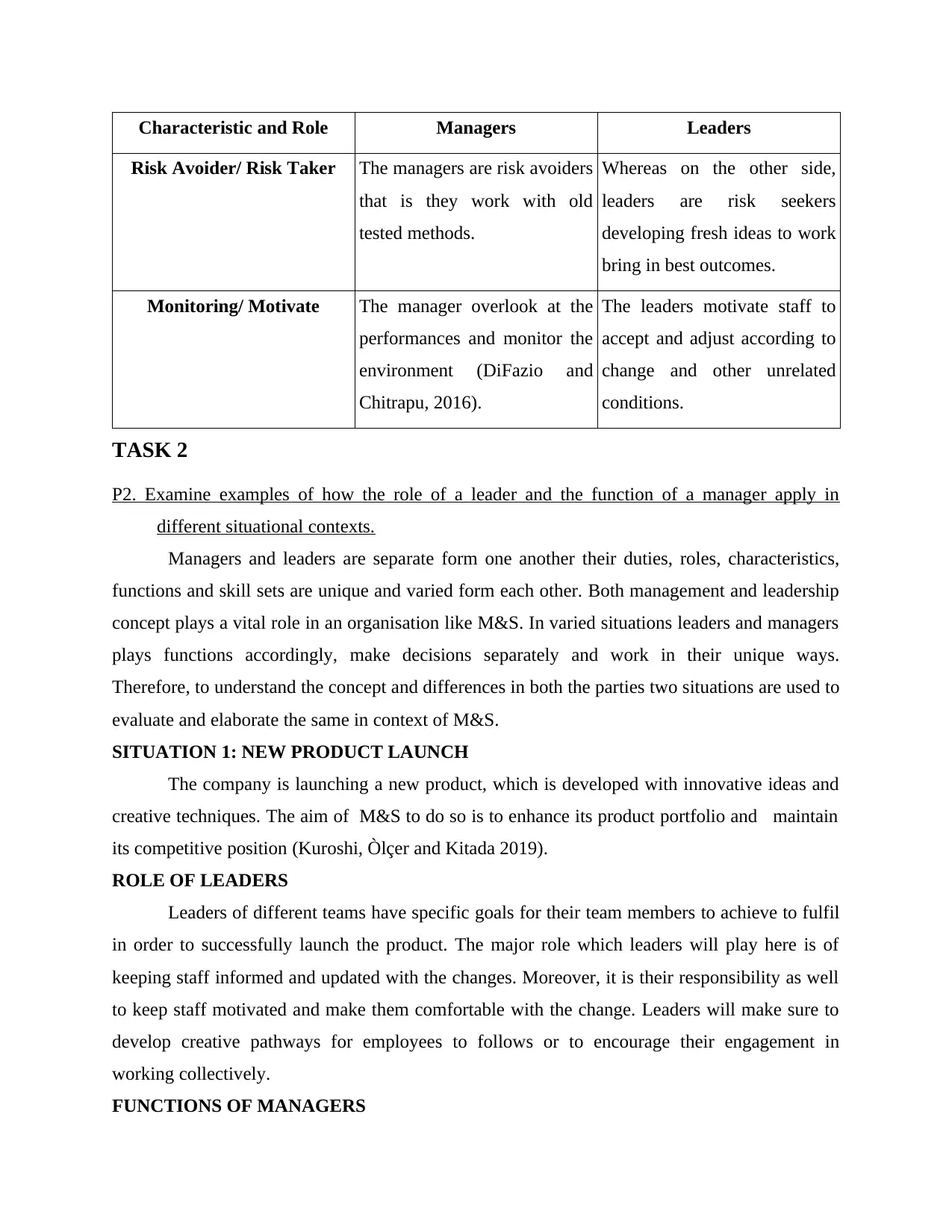
Characteristic and Role Managers Leaders
Risk Avoider/ Risk Taker The managers are risk avoiders
that is they work with old
tested methods.
Whereas on the other side,
leaders are risk seekers
developing fresh ideas to work
bring in best outcomes.
Monitoring/ Motivate The manager overlook at the
performances and monitor the
environment (DiFazio and
Chitrapu, 2016).
The leaders motivate staff to
accept and adjust according to
change and other unrelated
conditions.
TASK 2
P2. Examine examples of how the role of a leader and the function of a manager apply in
different situational contexts.
Managers and leaders are separate form one another their duties, roles, characteristics,
functions and skill sets are unique and varied form each other. Both management and leadership
concept plays a vital role in an organisation like M&S. In varied situations leaders and managers
plays functions accordingly, make decisions separately and work in their unique ways.
Therefore, to understand the concept and differences in both the parties two situations are used to
evaluate and elaborate the same in context of M&S.
SITUATION 1: NEW PRODUCT LAUNCH
The company is launching a new product, which is developed with innovative ideas and
creative techniques. The aim of M&S to do so is to enhance its product portfolio and maintain
its competitive position (Kuroshi, Òlçer and Kitada 2019).
ROLE OF LEADERS
Leaders of different teams have specific goals for their team members to achieve to fulfil
in order to successfully launch the product. The major role which leaders will play here is of
keeping staff informed and updated with the changes. Moreover, it is their responsibility as well
to keep staff motivated and make them comfortable with the change. Leaders will make sure to
develop creative pathways for employees to follows or to encourage their engagement in
working collectively.
FUNCTIONS OF MANAGERS
Risk Avoider/ Risk Taker The managers are risk avoiders
that is they work with old
tested methods.
Whereas on the other side,
leaders are risk seekers
developing fresh ideas to work
bring in best outcomes.
Monitoring/ Motivate The manager overlook at the
performances and monitor the
environment (DiFazio and
Chitrapu, 2016).
The leaders motivate staff to
accept and adjust according to
change and other unrelated
conditions.
TASK 2
P2. Examine examples of how the role of a leader and the function of a manager apply in
different situational contexts.
Managers and leaders are separate form one another their duties, roles, characteristics,
functions and skill sets are unique and varied form each other. Both management and leadership
concept plays a vital role in an organisation like M&S. In varied situations leaders and managers
plays functions accordingly, make decisions separately and work in their unique ways.
Therefore, to understand the concept and differences in both the parties two situations are used to
evaluate and elaborate the same in context of M&S.
SITUATION 1: NEW PRODUCT LAUNCH
The company is launching a new product, which is developed with innovative ideas and
creative techniques. The aim of M&S to do so is to enhance its product portfolio and maintain
its competitive position (Kuroshi, Òlçer and Kitada 2019).
ROLE OF LEADERS
Leaders of different teams have specific goals for their team members to achieve to fulfil
in order to successfully launch the product. The major role which leaders will play here is of
keeping staff informed and updated with the changes. Moreover, it is their responsibility as well
to keep staff motivated and make them comfortable with the change. Leaders will make sure to
develop creative pathways for employees to follows or to encourage their engagement in
working collectively.
FUNCTIONS OF MANAGERS
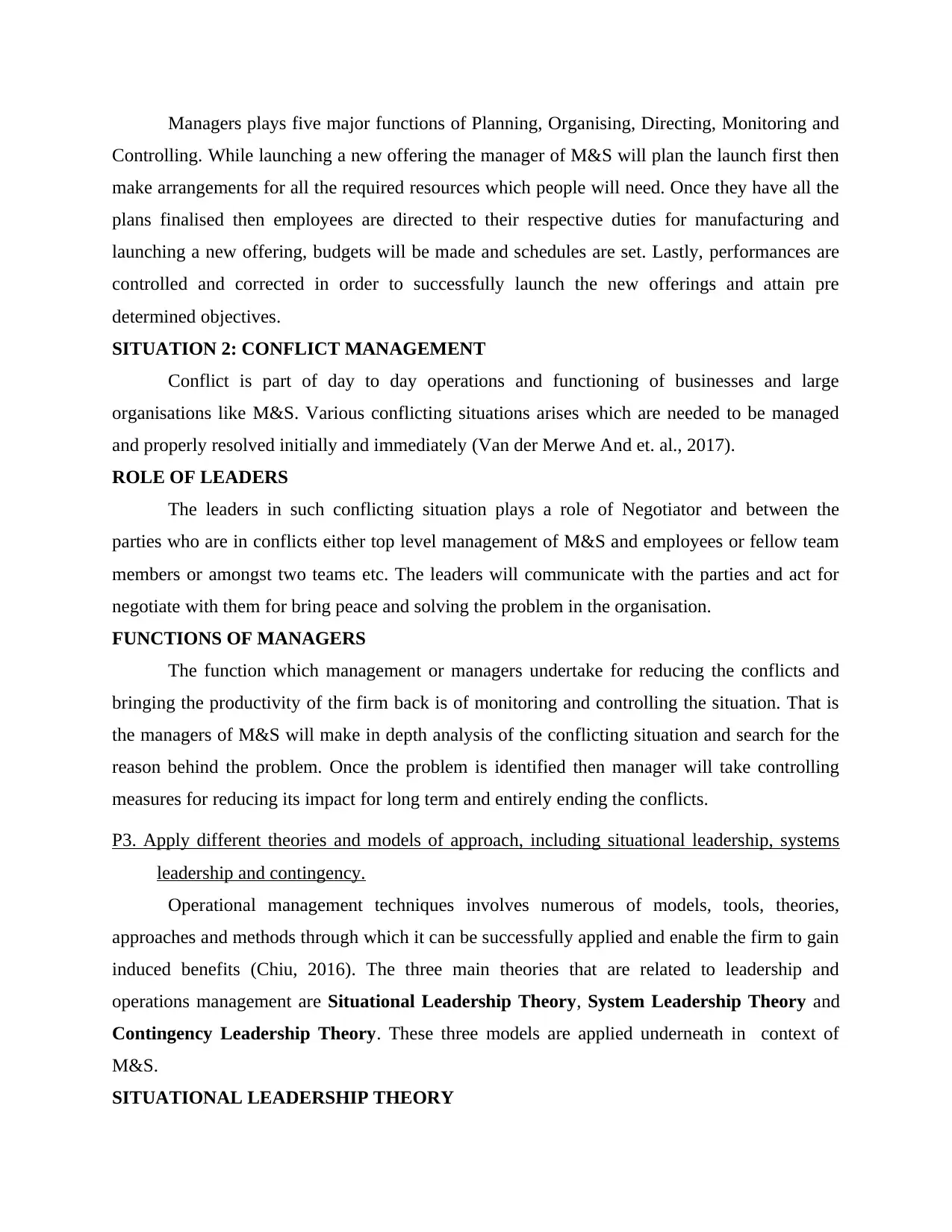
Managers plays five major functions of Planning, Organising, Directing, Monitoring and
Controlling. While launching a new offering the manager of M&S will plan the launch first then
make arrangements for all the required resources which people will need. Once they have all the
plans finalised then employees are directed to their respective duties for manufacturing and
launching a new offering, budgets will be made and schedules are set. Lastly, performances are
controlled and corrected in order to successfully launch the new offerings and attain pre
determined objectives.
SITUATION 2: CONFLICT MANAGEMENT
Conflict is part of day to day operations and functioning of businesses and large
organisations like M&S. Various conflicting situations arises which are needed to be managed
and properly resolved initially and immediately (Van der Merwe And et. al., 2017).
ROLE OF LEADERS
The leaders in such conflicting situation plays a role of Negotiator and between the
parties who are in conflicts either top level management of M&S and employees or fellow team
members or amongst two teams etc. The leaders will communicate with the parties and act for
negotiate with them for bring peace and solving the problem in the organisation.
FUNCTIONS OF MANAGERS
The function which management or managers undertake for reducing the conflicts and
bringing the productivity of the firm back is of monitoring and controlling the situation. That is
the managers of M&S will make in depth analysis of the conflicting situation and search for the
reason behind the problem. Once the problem is identified then manager will take controlling
measures for reducing its impact for long term and entirely ending the conflicts.
P3. Apply different theories and models of approach, including situational leadership, systems
leadership and contingency.
Operational management techniques involves numerous of models, tools, theories,
approaches and methods through which it can be successfully applied and enable the firm to gain
induced benefits (Chiu, 2016). The three main theories that are related to leadership and
operations management are Situational Leadership Theory, System Leadership Theory and
Contingency Leadership Theory. These three models are applied underneath in context of
M&S.
SITUATIONAL LEADERSHIP THEORY
Controlling. While launching a new offering the manager of M&S will plan the launch first then
make arrangements for all the required resources which people will need. Once they have all the
plans finalised then employees are directed to their respective duties for manufacturing and
launching a new offering, budgets will be made and schedules are set. Lastly, performances are
controlled and corrected in order to successfully launch the new offerings and attain pre
determined objectives.
SITUATION 2: CONFLICT MANAGEMENT
Conflict is part of day to day operations and functioning of businesses and large
organisations like M&S. Various conflicting situations arises which are needed to be managed
and properly resolved initially and immediately (Van der Merwe And et. al., 2017).
ROLE OF LEADERS
The leaders in such conflicting situation plays a role of Negotiator and between the
parties who are in conflicts either top level management of M&S and employees or fellow team
members or amongst two teams etc. The leaders will communicate with the parties and act for
negotiate with them for bring peace and solving the problem in the organisation.
FUNCTIONS OF MANAGERS
The function which management or managers undertake for reducing the conflicts and
bringing the productivity of the firm back is of monitoring and controlling the situation. That is
the managers of M&S will make in depth analysis of the conflicting situation and search for the
reason behind the problem. Once the problem is identified then manager will take controlling
measures for reducing its impact for long term and entirely ending the conflicts.
P3. Apply different theories and models of approach, including situational leadership, systems
leadership and contingency.
Operational management techniques involves numerous of models, tools, theories,
approaches and methods through which it can be successfully applied and enable the firm to gain
induced benefits (Chiu, 2016). The three main theories that are related to leadership and
operations management are Situational Leadership Theory, System Leadership Theory and
Contingency Leadership Theory. These three models are applied underneath in context of
M&S.
SITUATIONAL LEADERSHIP THEORY
⊘ This is a preview!⊘
Do you want full access?
Subscribe today to unlock all pages.

Trusted by 1+ million students worldwide
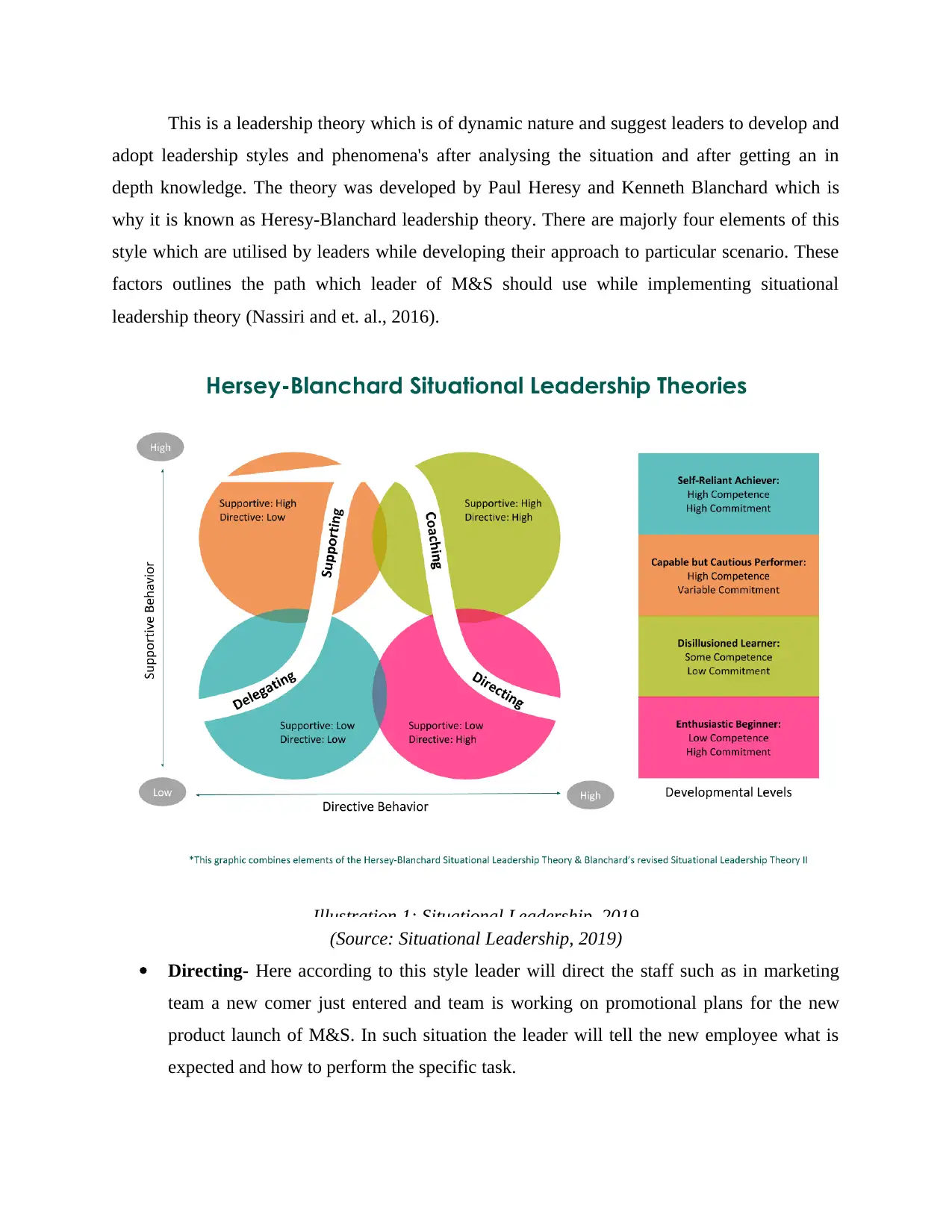
This is a leadership theory which is of dynamic nature and suggest leaders to develop and
adopt leadership styles and phenomena's after analysing the situation and after getting an in
depth knowledge. The theory was developed by Paul Heresy and Kenneth Blanchard which is
why it is known as Heresy-Blanchard leadership theory. There are majorly four elements of this
style which are utilised by leaders while developing their approach to particular scenario. These
factors outlines the path which leader of M&S should use while implementing situational
leadership theory (Nassiri and et. al., 2016).
Illustration 1: Situational Leadership, 2019
(Source: Situational Leadership, 2019)
Directing- Here according to this style leader will direct the staff such as in marketing
team a new comer just entered and team is working on promotional plans for the new
product launch of M&S. In such situation the leader will tell the new employee what is
expected and how to perform the specific task.
adopt leadership styles and phenomena's after analysing the situation and after getting an in
depth knowledge. The theory was developed by Paul Heresy and Kenneth Blanchard which is
why it is known as Heresy-Blanchard leadership theory. There are majorly four elements of this
style which are utilised by leaders while developing their approach to particular scenario. These
factors outlines the path which leader of M&S should use while implementing situational
leadership theory (Nassiri and et. al., 2016).
Illustration 1: Situational Leadership, 2019
(Source: Situational Leadership, 2019)
Directing- Here according to this style leader will direct the staff such as in marketing
team a new comer just entered and team is working on promotional plans for the new
product launch of M&S. In such situation the leader will tell the new employee what is
expected and how to perform the specific task.
Paraphrase This Document
Need a fresh take? Get an instant paraphrase of this document with our AI Paraphraser
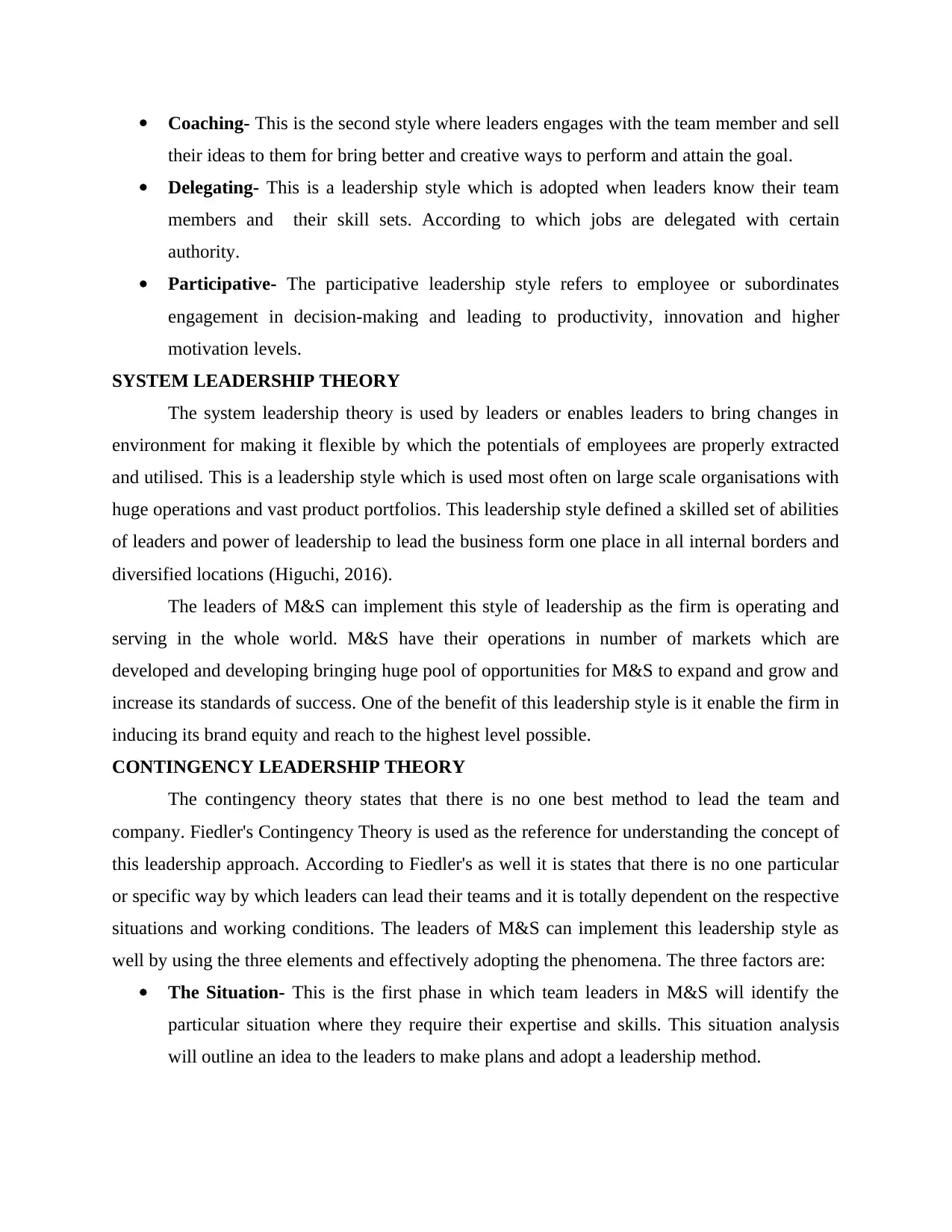
Coaching- This is the second style where leaders engages with the team member and sell
their ideas to them for bring better and creative ways to perform and attain the goal.
Delegating- This is a leadership style which is adopted when leaders know their team
members and their skill sets. According to which jobs are delegated with certain
authority.
Participative- The participative leadership style refers to employee or subordinates
engagement in decision-making and leading to productivity, innovation and higher
motivation levels.
SYSTEM LEADERSHIP THEORY
The system leadership theory is used by leaders or enables leaders to bring changes in
environment for making it flexible by which the potentials of employees are properly extracted
and utilised. This is a leadership style which is used most often on large scale organisations with
huge operations and vast product portfolios. This leadership style defined a skilled set of abilities
of leaders and power of leadership to lead the business form one place in all internal borders and
diversified locations (Higuchi, 2016).
The leaders of M&S can implement this style of leadership as the firm is operating and
serving in the whole world. M&S have their operations in number of markets which are
developed and developing bringing huge pool of opportunities for M&S to expand and grow and
increase its standards of success. One of the benefit of this leadership style is it enable the firm in
inducing its brand equity and reach to the highest level possible.
CONTINGENCY LEADERSHIP THEORY
The contingency theory states that there is no one best method to lead the team and
company. Fiedler's Contingency Theory is used as the reference for understanding the concept of
this leadership approach. According to Fiedler's as well it is states that there is no one particular
or specific way by which leaders can lead their teams and it is totally dependent on the respective
situations and working conditions. The leaders of M&S can implement this leadership style as
well by using the three elements and effectively adopting the phenomena. The three factors are:
The Situation- This is the first phase in which team leaders in M&S will identify the
particular situation where they require their expertise and skills. This situation analysis
will outline an idea to the leaders to make plans and adopt a leadership method.
their ideas to them for bring better and creative ways to perform and attain the goal.
Delegating- This is a leadership style which is adopted when leaders know their team
members and their skill sets. According to which jobs are delegated with certain
authority.
Participative- The participative leadership style refers to employee or subordinates
engagement in decision-making and leading to productivity, innovation and higher
motivation levels.
SYSTEM LEADERSHIP THEORY
The system leadership theory is used by leaders or enables leaders to bring changes in
environment for making it flexible by which the potentials of employees are properly extracted
and utilised. This is a leadership style which is used most often on large scale organisations with
huge operations and vast product portfolios. This leadership style defined a skilled set of abilities
of leaders and power of leadership to lead the business form one place in all internal borders and
diversified locations (Higuchi, 2016).
The leaders of M&S can implement this style of leadership as the firm is operating and
serving in the whole world. M&S have their operations in number of markets which are
developed and developing bringing huge pool of opportunities for M&S to expand and grow and
increase its standards of success. One of the benefit of this leadership style is it enable the firm in
inducing its brand equity and reach to the highest level possible.
CONTINGENCY LEADERSHIP THEORY
The contingency theory states that there is no one best method to lead the team and
company. Fiedler's Contingency Theory is used as the reference for understanding the concept of
this leadership approach. According to Fiedler's as well it is states that there is no one particular
or specific way by which leaders can lead their teams and it is totally dependent on the respective
situations and working conditions. The leaders of M&S can implement this leadership style as
well by using the three elements and effectively adopting the phenomena. The three factors are:
The Situation- This is the first phase in which team leaders in M&S will identify the
particular situation where they require their expertise and skills. This situation analysis
will outline an idea to the leaders to make plans and adopt a leadership method.
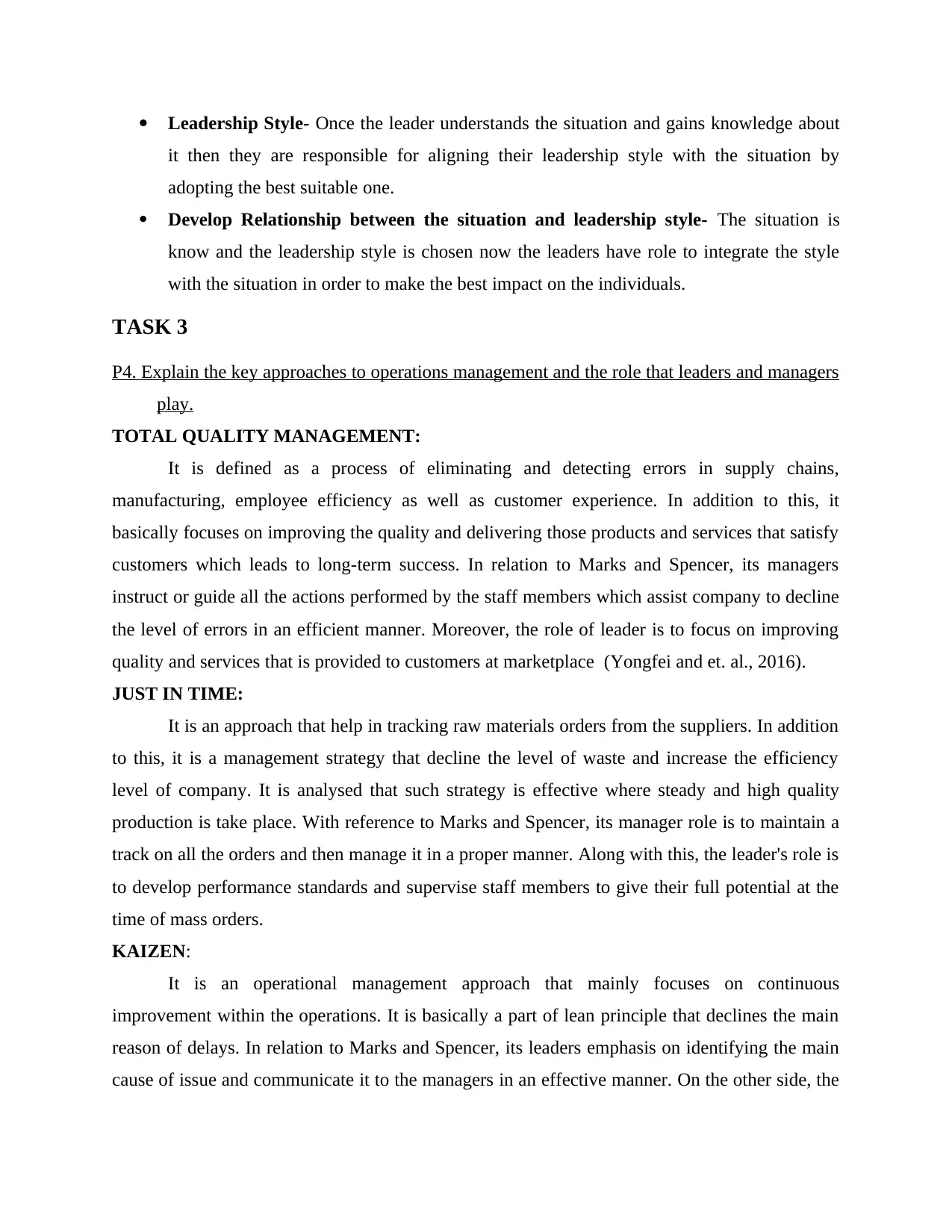
Leadership Style- Once the leader understands the situation and gains knowledge about
it then they are responsible for aligning their leadership style with the situation by
adopting the best suitable one.
Develop Relationship between the situation and leadership style- The situation is
know and the leadership style is chosen now the leaders have role to integrate the style
with the situation in order to make the best impact on the individuals.
TASK 3
P4. Explain the key approaches to operations management and the role that leaders and managers
play.
TOTAL QUALITY MANAGEMENT:
It is defined as a process of eliminating and detecting errors in supply chains,
manufacturing, employee efficiency as well as customer experience. In addition to this, it
basically focuses on improving the quality and delivering those products and services that satisfy
customers which leads to long-term success. In relation to Marks and Spencer, its managers
instruct or guide all the actions performed by the staff members which assist company to decline
the level of errors in an efficient manner. Moreover, the role of leader is to focus on improving
quality and services that is provided to customers at marketplace (Yongfei and et. al., 2016).
JUST IN TIME:
It is an approach that help in tracking raw materials orders from the suppliers. In addition
to this, it is a management strategy that decline the level of waste and increase the efficiency
level of company. It is analysed that such strategy is effective where steady and high quality
production is take place. With reference to Marks and Spencer, its manager role is to maintain a
track on all the orders and then manage it in a proper manner. Along with this, the leader's role is
to develop performance standards and supervise staff members to give their full potential at the
time of mass orders.
KAIZEN:
It is an operational management approach that mainly focuses on continuous
improvement within the operations. It is basically a part of lean principle that declines the main
reason of delays. In relation to Marks and Spencer, its leaders emphasis on identifying the main
cause of issue and communicate it to the managers in an effective manner. On the other side, the
it then they are responsible for aligning their leadership style with the situation by
adopting the best suitable one.
Develop Relationship between the situation and leadership style- The situation is
know and the leadership style is chosen now the leaders have role to integrate the style
with the situation in order to make the best impact on the individuals.
TASK 3
P4. Explain the key approaches to operations management and the role that leaders and managers
play.
TOTAL QUALITY MANAGEMENT:
It is defined as a process of eliminating and detecting errors in supply chains,
manufacturing, employee efficiency as well as customer experience. In addition to this, it
basically focuses on improving the quality and delivering those products and services that satisfy
customers which leads to long-term success. In relation to Marks and Spencer, its managers
instruct or guide all the actions performed by the staff members which assist company to decline
the level of errors in an efficient manner. Moreover, the role of leader is to focus on improving
quality and services that is provided to customers at marketplace (Yongfei and et. al., 2016).
JUST IN TIME:
It is an approach that help in tracking raw materials orders from the suppliers. In addition
to this, it is a management strategy that decline the level of waste and increase the efficiency
level of company. It is analysed that such strategy is effective where steady and high quality
production is take place. With reference to Marks and Spencer, its manager role is to maintain a
track on all the orders and then manage it in a proper manner. Along with this, the leader's role is
to develop performance standards and supervise staff members to give their full potential at the
time of mass orders.
KAIZEN:
It is an operational management approach that mainly focuses on continuous
improvement within the operations. It is basically a part of lean principle that declines the main
reason of delays. In relation to Marks and Spencer, its leaders emphasis on identifying the main
cause of issue and communicate it to the managers in an effective manner. On the other side, the
⊘ This is a preview!⊘
Do you want full access?
Subscribe today to unlock all pages.

Trusted by 1+ million students worldwide
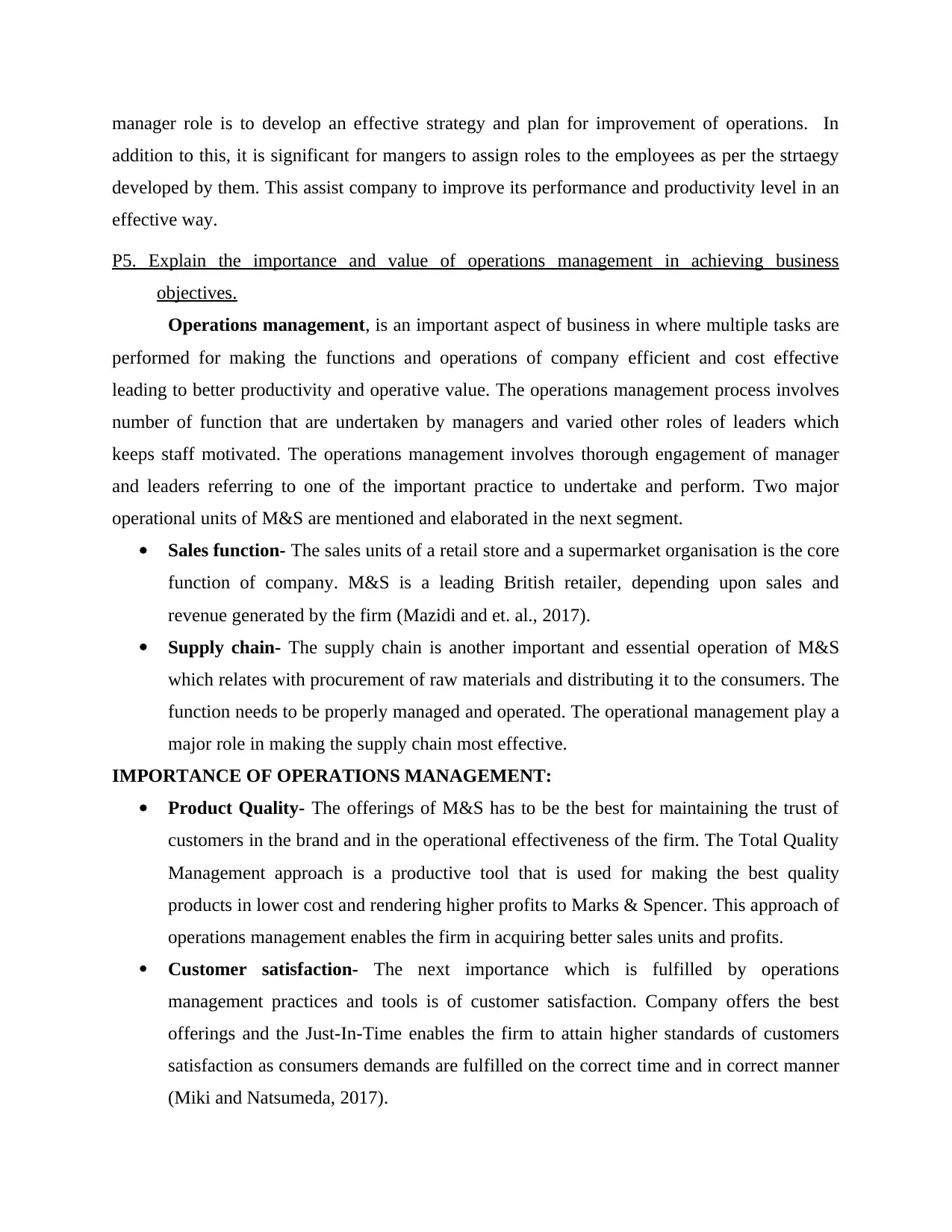
manager role is to develop an effective strategy and plan for improvement of operations. In
addition to this, it is significant for mangers to assign roles to the employees as per the strtaegy
developed by them. This assist company to improve its performance and productivity level in an
effective way.
P5. Explain the importance and value of operations management in achieving business
objectives.
Operations management, is an important aspect of business in where multiple tasks are
performed for making the functions and operations of company efficient and cost effective
leading to better productivity and operative value. The operations management process involves
number of function that are undertaken by managers and varied other roles of leaders which
keeps staff motivated. The operations management involves thorough engagement of manager
and leaders referring to one of the important practice to undertake and perform. Two major
operational units of M&S are mentioned and elaborated in the next segment.
Sales function- The sales units of a retail store and a supermarket organisation is the core
function of company. M&S is a leading British retailer, depending upon sales and
revenue generated by the firm (Mazidi and et. al., 2017).
Supply chain- The supply chain is another important and essential operation of M&S
which relates with procurement of raw materials and distributing it to the consumers. The
function needs to be properly managed and operated. The operational management play a
major role in making the supply chain most effective.
IMPORTANCE OF OPERATIONS MANAGEMENT:
Product Quality- The offerings of M&S has to be the best for maintaining the trust of
customers in the brand and in the operational effectiveness of the firm. The Total Quality
Management approach is a productive tool that is used for making the best quality
products in lower cost and rendering higher profits to Marks & Spencer. This approach of
operations management enables the firm in acquiring better sales units and profits.
Customer satisfaction- The next importance which is fulfilled by operations
management practices and tools is of customer satisfaction. Company offers the best
offerings and the Just-In-Time enables the firm to attain higher standards of customers
satisfaction as consumers demands are fulfilled on the correct time and in correct manner
(Miki and Natsumeda, 2017).
addition to this, it is significant for mangers to assign roles to the employees as per the strtaegy
developed by them. This assist company to improve its performance and productivity level in an
effective way.
P5. Explain the importance and value of operations management in achieving business
objectives.
Operations management, is an important aspect of business in where multiple tasks are
performed for making the functions and operations of company efficient and cost effective
leading to better productivity and operative value. The operations management process involves
number of function that are undertaken by managers and varied other roles of leaders which
keeps staff motivated. The operations management involves thorough engagement of manager
and leaders referring to one of the important practice to undertake and perform. Two major
operational units of M&S are mentioned and elaborated in the next segment.
Sales function- The sales units of a retail store and a supermarket organisation is the core
function of company. M&S is a leading British retailer, depending upon sales and
revenue generated by the firm (Mazidi and et. al., 2017).
Supply chain- The supply chain is another important and essential operation of M&S
which relates with procurement of raw materials and distributing it to the consumers. The
function needs to be properly managed and operated. The operational management play a
major role in making the supply chain most effective.
IMPORTANCE OF OPERATIONS MANAGEMENT:
Product Quality- The offerings of M&S has to be the best for maintaining the trust of
customers in the brand and in the operational effectiveness of the firm. The Total Quality
Management approach is a productive tool that is used for making the best quality
products in lower cost and rendering higher profits to Marks & Spencer. This approach of
operations management enables the firm in acquiring better sales units and profits.
Customer satisfaction- The next importance which is fulfilled by operations
management practices and tools is of customer satisfaction. Company offers the best
offerings and the Just-In-Time enables the firm to attain higher standards of customers
satisfaction as consumers demands are fulfilled on the correct time and in correct manner
(Miki and Natsumeda, 2017).
Paraphrase This Document
Need a fresh take? Get an instant paraphrase of this document with our AI Paraphraser
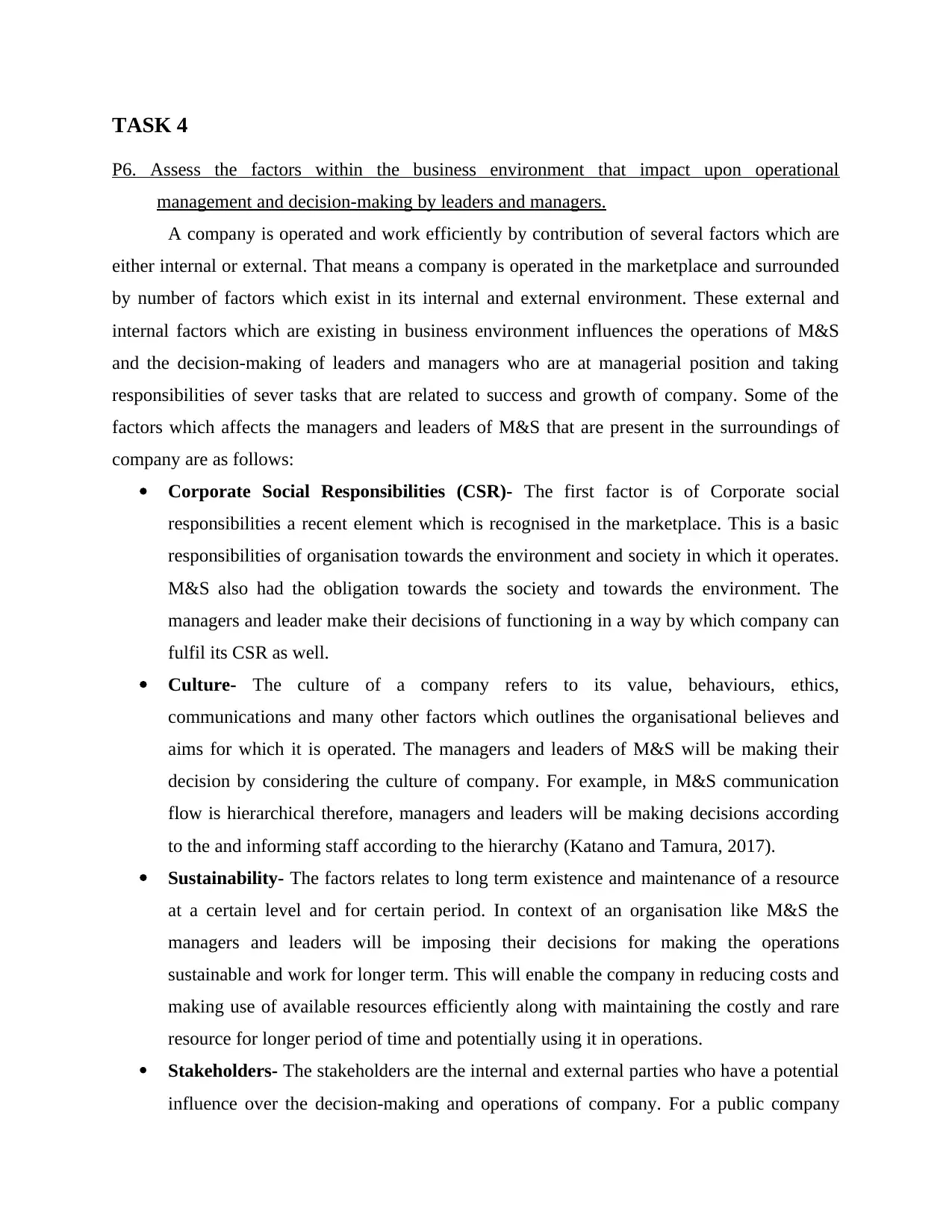
TASK 4
P6. Assess the factors within the business environment that impact upon operational
management and decision-making by leaders and managers.
A company is operated and work efficiently by contribution of several factors which are
either internal or external. That means a company is operated in the marketplace and surrounded
by number of factors which exist in its internal and external environment. These external and
internal factors which are existing in business environment influences the operations of M&S
and the decision-making of leaders and managers who are at managerial position and taking
responsibilities of sever tasks that are related to success and growth of company. Some of the
factors which affects the managers and leaders of M&S that are present in the surroundings of
company are as follows:
Corporate Social Responsibilities (CSR)- The first factor is of Corporate social
responsibilities a recent element which is recognised in the marketplace. This is a basic
responsibilities of organisation towards the environment and society in which it operates.
M&S also had the obligation towards the society and towards the environment. The
managers and leader make their decisions of functioning in a way by which company can
fulfil its CSR as well.
Culture- The culture of a company refers to its value, behaviours, ethics,
communications and many other factors which outlines the organisational believes and
aims for which it is operated. The managers and leaders of M&S will be making their
decision by considering the culture of company. For example, in M&S communication
flow is hierarchical therefore, managers and leaders will be making decisions according
to the and informing staff according to the hierarchy (Katano and Tamura, 2017).
Sustainability- The factors relates to long term existence and maintenance of a resource
at a certain level and for certain period. In context of an organisation like M&S the
managers and leaders will be imposing their decisions for making the operations
sustainable and work for longer term. This will enable the company in reducing costs and
making use of available resources efficiently along with maintaining the costly and rare
resource for longer period of time and potentially using it in operations.
Stakeholders- The stakeholders are the internal and external parties who have a potential
influence over the decision-making and operations of company. For a public company
P6. Assess the factors within the business environment that impact upon operational
management and decision-making by leaders and managers.
A company is operated and work efficiently by contribution of several factors which are
either internal or external. That means a company is operated in the marketplace and surrounded
by number of factors which exist in its internal and external environment. These external and
internal factors which are existing in business environment influences the operations of M&S
and the decision-making of leaders and managers who are at managerial position and taking
responsibilities of sever tasks that are related to success and growth of company. Some of the
factors which affects the managers and leaders of M&S that are present in the surroundings of
company are as follows:
Corporate Social Responsibilities (CSR)- The first factor is of Corporate social
responsibilities a recent element which is recognised in the marketplace. This is a basic
responsibilities of organisation towards the environment and society in which it operates.
M&S also had the obligation towards the society and towards the environment. The
managers and leader make their decisions of functioning in a way by which company can
fulfil its CSR as well.
Culture- The culture of a company refers to its value, behaviours, ethics,
communications and many other factors which outlines the organisational believes and
aims for which it is operated. The managers and leaders of M&S will be making their
decision by considering the culture of company. For example, in M&S communication
flow is hierarchical therefore, managers and leaders will be making decisions according
to the and informing staff according to the hierarchy (Katano and Tamura, 2017).
Sustainability- The factors relates to long term existence and maintenance of a resource
at a certain level and for certain period. In context of an organisation like M&S the
managers and leaders will be imposing their decisions for making the operations
sustainable and work for longer term. This will enable the company in reducing costs and
making use of available resources efficiently along with maintaining the costly and rare
resource for longer period of time and potentially using it in operations.
Stakeholders- The stakeholders are the internal and external parties who have a potential
influence over the decision-making and operations of company. For a public company
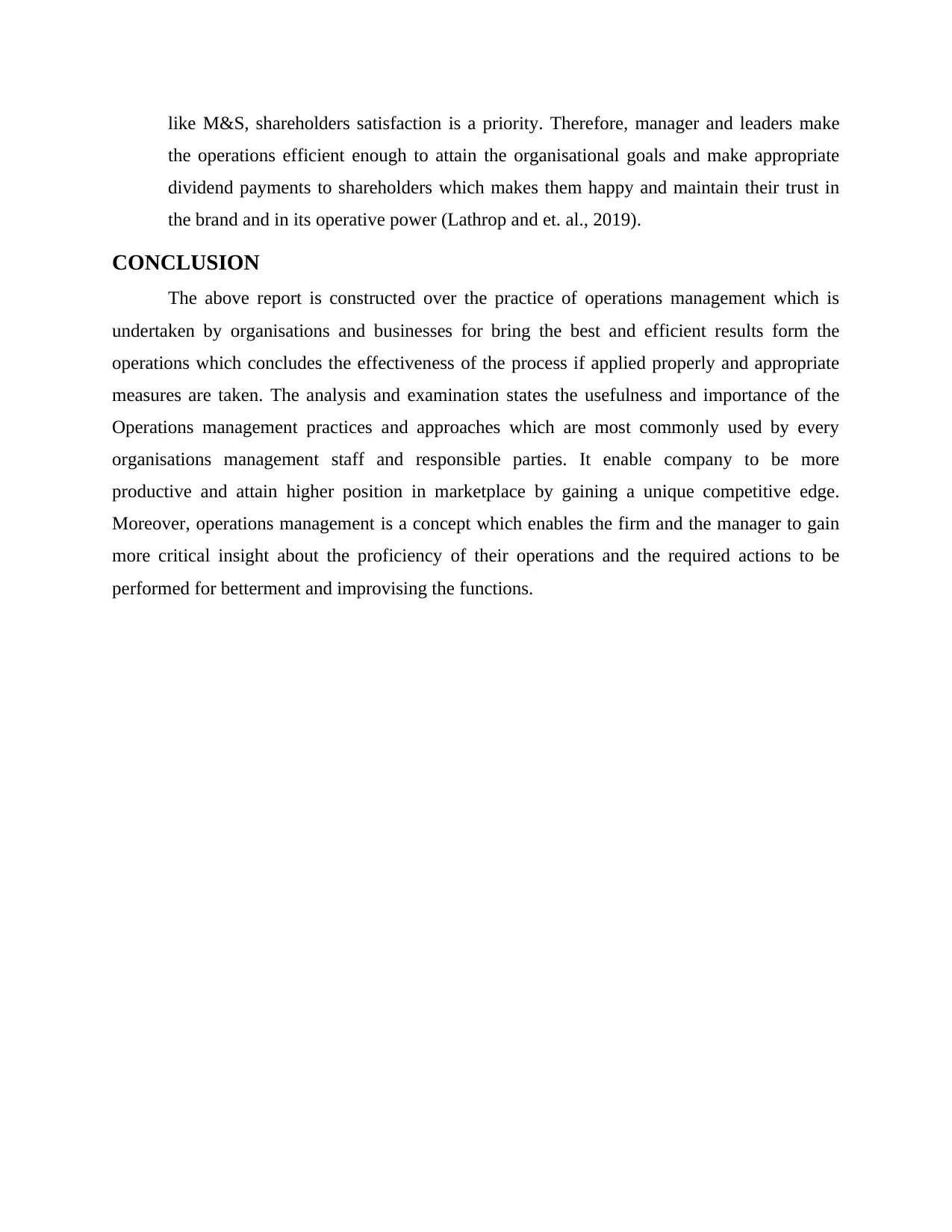
like M&S, shareholders satisfaction is a priority. Therefore, manager and leaders make
the operations efficient enough to attain the organisational goals and make appropriate
dividend payments to shareholders which makes them happy and maintain their trust in
the brand and in its operative power (Lathrop and et. al., 2019).
CONCLUSION
The above report is constructed over the practice of operations management which is
undertaken by organisations and businesses for bring the best and efficient results form the
operations which concludes the effectiveness of the process if applied properly and appropriate
measures are taken. The analysis and examination states the usefulness and importance of the
Operations management practices and approaches which are most commonly used by every
organisations management staff and responsible parties. It enable company to be more
productive and attain higher position in marketplace by gaining a unique competitive edge.
Moreover, operations management is a concept which enables the firm and the manager to gain
more critical insight about the proficiency of their operations and the required actions to be
performed for betterment and improvising the functions.
the operations efficient enough to attain the organisational goals and make appropriate
dividend payments to shareholders which makes them happy and maintain their trust in
the brand and in its operative power (Lathrop and et. al., 2019).
CONCLUSION
The above report is constructed over the practice of operations management which is
undertaken by organisations and businesses for bring the best and efficient results form the
operations which concludes the effectiveness of the process if applied properly and appropriate
measures are taken. The analysis and examination states the usefulness and importance of the
Operations management practices and approaches which are most commonly used by every
organisations management staff and responsible parties. It enable company to be more
productive and attain higher position in marketplace by gaining a unique competitive edge.
Moreover, operations management is a concept which enables the firm and the manager to gain
more critical insight about the proficiency of their operations and the required actions to be
performed for betterment and improvising the functions.
⊘ This is a preview!⊘
Do you want full access?
Subscribe today to unlock all pages.

Trusted by 1+ million students worldwide
1 out of 13
Related Documents
Your All-in-One AI-Powered Toolkit for Academic Success.
+13062052269
info@desklib.com
Available 24*7 on WhatsApp / Email
![[object Object]](/_next/static/media/star-bottom.7253800d.svg)
Unlock your academic potential
Copyright © 2020–2025 A2Z Services. All Rights Reserved. Developed and managed by ZUCOL.





